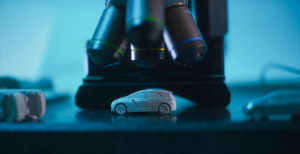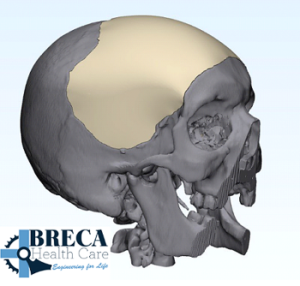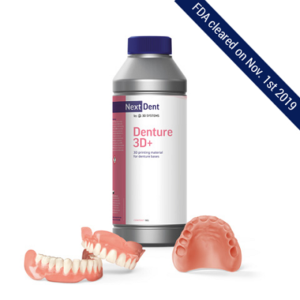In today’s 3D Printing News Briefs, we’re talking a little business, then moving on to some medical news. Volkswagen has achieved a major metal 3D printing milestone with HP, and BASF has certified a 3D printed autoclave as pressure equipment for the first time. BRECA Health Care has renewed its 3D printed medical device license in Europe, and 3D Systems’ NextDentR Denture 3D+ has received FDA clearance.
Volkswagen Reaches Milestone with HP Metal Jet Printing
 In 2018, Volkswagen chose to adopt HP’s Metal Jet 3D printing technology to help achieve its three-phase strategic roadmap to functional AM production. Soon, it will reach a production run of over 10,000 high-quality metal parts 3D printed by HP and GKN Powder Metallurgy, just in time to support the launch event of its ID.3 electric vehicle – the first fully electric production car with a CO2-neutral footprint. Over the next two phases of its plan, Volkswagen will quickly integrate Metal Jet 3D printed structural parts into its next generation of vehicles, with a goal of continually increasing the part size and technical requirements. The company is partnering with GKN to 3D print functional metal parts for auto and industrial leaders on HP’s Metal Jet factories, as well as thousands of ID.3 models for the marketing campaign.
In 2018, Volkswagen chose to adopt HP’s Metal Jet 3D printing technology to help achieve its three-phase strategic roadmap to functional AM production. Soon, it will reach a production run of over 10,000 high-quality metal parts 3D printed by HP and GKN Powder Metallurgy, just in time to support the launch event of its ID.3 electric vehicle – the first fully electric production car with a CO2-neutral footprint. Over the next two phases of its plan, Volkswagen will quickly integrate Metal Jet 3D printed structural parts into its next generation of vehicles, with a goal of continually increasing the part size and technical requirements. The company is partnering with GKN to 3D print functional metal parts for auto and industrial leaders on HP’s Metal Jet factories, as well as thousands of ID.3 models for the marketing campaign.
“Our vision to industrialize additive manufacturing is quickly becoming a reality with HP Metal Jet, it is a game changer for the automotive industry. The pace of innovation by HP and advanced capabiltiies of the technology have exceeded our expectations. We are meeting our milestones and are actively identifying and developing functional parts for production,” said Dr. Martin Goede, Volkswagen’s Head of Technology Planning and Development.
“What better way to showcase the innovation of Volkswagen than to use our own technologies in the marketing campaign for the premiere ID.3 launch. We are extremely pleased with the technical features and the speed, quality and low-cost per part that HP Metal Jet has provided. The surface quality and feature resolution enabled great attention to detail and made it possible to add a special touch to this important company milestone.”
HP will be showcasing its Metal Jet technology at this week’s FABTECH event in Chicago (Booth A3-638), as well as next week’s formnext in Frankfurt (Booth D21, Hall 12.1).
BASF Manufactures and Certifies First 3D Printed Pressure Equipment
 Chemical company BASF uses 3D printing to optimize components, which in turn improves chemical processes. Recently, the Technical Inspection at BASF SE, in its role as Notified Body (user inspectorate), certified the first 3D printed autoclave as a pressure equipment. BASF used SLM technology to manufacture the austenitic stainless steel component, which conforms to the European Pressure Equipment Directive (2014/68/EU), meets Category III requirements, and allows for faster temperature cycles. This is pretty important, as an autoclave is a container inside which a reaction between chemical components is triggered by pressure and temperature. BASF is now the first company to execute a certification process which includes a procedure qualification for 3D printed pressure equipment.
Chemical company BASF uses 3D printing to optimize components, which in turn improves chemical processes. Recently, the Technical Inspection at BASF SE, in its role as Notified Body (user inspectorate), certified the first 3D printed autoclave as a pressure equipment. BASF used SLM technology to manufacture the austenitic stainless steel component, which conforms to the European Pressure Equipment Directive (2014/68/EU), meets Category III requirements, and allows for faster temperature cycles. This is pretty important, as an autoclave is a container inside which a reaction between chemical components is triggered by pressure and temperature. BASF is now the first company to execute a certification process which includes a procedure qualification for 3D printed pressure equipment.
“We use additive manufacturing technology when it offers added value compared to conventional manufacturing methods,” said Dr. Alba Mena Subiranas, Maintenance & Reliability Solutions. “Pressure equipment poses a special challenge, particularly in design, manufacturing and certification.”
BRECA Health Care Renews License for 3D Printing Medical Devices
 Granada-based BRECA Health Care is continuing toward its goal of widespread 3D printing adoption in hospitals. Founded in 2011, the company has been something of a pioneer in terms of the technology’s use in clinical cases, and is working to become a leader at managing its use in hospitals, having performed hundreds of cases in countries ranging from Belgium and Saudi Arabia to Mexico and its native Spain. Now, BRECA announced that it’s had its license renewed to continue 3D printing custom medical devices in Europe until 2025. With this in mind, the company has also launched a service to help create an internal 3D printing laboratory in hospitals.
Granada-based BRECA Health Care is continuing toward its goal of widespread 3D printing adoption in hospitals. Founded in 2011, the company has been something of a pioneer in terms of the technology’s use in clinical cases, and is working to become a leader at managing its use in hospitals, having performed hundreds of cases in countries ranging from Belgium and Saudi Arabia to Mexico and its native Spain. Now, BRECA announced that it’s had its license renewed to continue 3D printing custom medical devices in Europe until 2025. With this in mind, the company has also launched a service to help create an internal 3D printing laboratory in hospitals.
“We are very happy to be able to continue doing this type of reconstructions,” said José Manuel Baena, PhD in Biomedicine and Industrial Engineer and founder of BRECA Health Care and REGEMAT 3D. “The first license was given to us in 2014 and needs to be renewed every 5 years. In 2014 it was quite complicated since there was practically no information and the autonomous communities did not have a very established process, since they were based on the licenses that are given to orthopaedics to customize technical aids and the implantable products are very different. Now the process is much more defined and even hospitals are trying to get this license to make some products in house.”
NextDentR Denture 3D+ Receives FDA clearance
 3D Systems announced that its biocompatible NextDent Denture 3D+ material has officially received 510(k) clearance from the FDA. The material – the latest in the company’s portfolio of NextDent dental resins – has great mechanical properties, and helps dental labs and clinics produce dentures at a 90% lower cost and 75% faster. By combining the material with the company’s NextDent 5100 dental 3D printer and intra-oral scanning and dental software solutions, you’ve got a great end-to-end digital dentistry solution that ensures efficiency, cost savings, and properly fitted devices.
3D Systems announced that its biocompatible NextDent Denture 3D+ material has officially received 510(k) clearance from the FDA. The material – the latest in the company’s portfolio of NextDent dental resins – has great mechanical properties, and helps dental labs and clinics produce dentures at a 90% lower cost and 75% faster. By combining the material with the company’s NextDent 5100 dental 3D printer and intra-oral scanning and dental software solutions, you’ve got a great end-to-end digital dentistry solution that ensures efficiency, cost savings, and properly fitted devices.
“With 3D Systems’ Digital Denture Workflow, dental laboratories and clinics are now able to produce dental devices at dramatically increased speed while reducing material waste and capital equipment expenditure as well as reliance upon milling centers. FDA clearance of NextDent Denture 3D+ is the last piece that creates a trusted end-to-end workflow – giving prosthodontists a competitive advantage while improving the patient experience,” said Rik Jacobs, Vice President and General Manager, Dental, 3D Systems.
Discuss these stories and other 3D printing topics at 3DPrintBoard.com or share your thoughts in the Facebook comments below.
Subscribe to Our Email Newsletter
Stay up-to-date on all the latest news from the 3D printing industry and receive information and offers from third party vendors.
You May Also Like
HILOS Launches Studio OS for AI-Driven 3D Printed Shoe Design
At Milan Design Week, footwear 3D printing startup HILOS has unveiled its latest development, Studio OS. Introduced at the historical Villa Bagatti Valsecchi, the platform is meant to redefine how...
3D Printing Webinar and Event Roundup: April 28, 2024
In this week’s 3D Printing Webinar and Event Roundup, the Ceramics Expo is taking place in Michigan, Stratasys continues its advanced training courses, and SPE is holding a Polymer Characterization...
Initial Speakers and Sponsors Announced for Additive Manufacturing Strategies 2025
Nearly a year away from the event, the Additive Manufacturing Strategies (AMS) 2025 conference is already beginning to take shape. Building upon the success of 2024’s summit, AMS has established...
HP & INDO-MIM Collaborate to Boost Metal 3D Printing in India
HP Inc. and INDO-MIM, a US- and India-based supplier of metal injection molding (MIM) powders and contract manufacturer, have announced that the two companies will collaborate to accelerate additive manufacturing...































